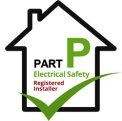When it comes to fire safety, emergency lighting is one of the most important systems in any building. In the event of a power failure or fire, these lights provide essential guidance to help occupants exit the building safely and quickly. Beyond protecting people, emergency lighting is also a legal requirement for most commercial and rented premises in the UK.
Like any electrical installation, emergency lights need regular testing and maintenance to ensure they will work when you need them most. Without proper checks, batteries may fail, bulbs could stop working, or wiring might become damaged – leaving you exposed to both safety risks and compliance issues.
In this comprehensive guide, we’ll walk you through everything you need to know about emergency light testing, from understanding what these systems are and how they work, to the UK regulations you must follow, how often to test, and what the process involves. Whether you’re a landlord, facilities manager, or business owner, this article will give you clarity and confidence in meeting your obligations.
Your guide to emergency light testing
At Heath Electrical Services, we’ve been helping businesses, landlords, and homeowners across Milton Keynes and the surrounding areas stay compliant and safe for decades. Our team of NICEIC-approved electricians carries out emergency light testing, installation, and maintenance across a wide range of premises – from offices and schools to residential blocks and industrial sites.
We know that understanding your responsibilities can sometimes feel overwhelming, which is why we’ve put together this straightforward guide. Below, we’ll cover the key areas you need to know:
- What is emergency lighting?
- What does testing involve?
- What are the emergency lighting testing requirements UK?
- How often should emergency lighting be tested?
- How to test emergency lights
- Why professional testing matters
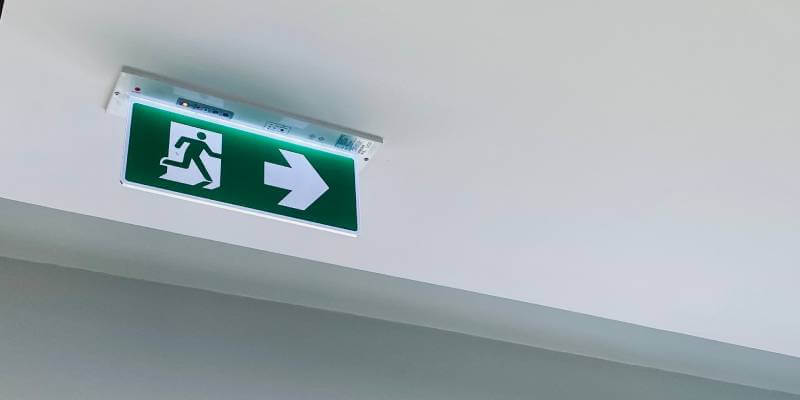
What is emergency lighting?
Before diving into the details of testing, it’s important to understand exactly what emergency lighting is – and why it matters.
In the UK, emergency escape lighting is a legal requirement under both the Building Regulations and the Regulatory Reform (Fire Safety) Order 2005. This means that all types of business premises – including offices, factories, schools, hospitals, pubs, clubs, entertainment venues, and even temporary structures like tents and marquees – must have adequate emergency lighting installed.
Emergency lighting is designed to automatically switch on if the mains power supply fails. Backed up by batteries, these lights help guide occupants safely out of the building, illuminate escape routes and exits, and ensure that hazardous areas remain visible. In some cases, they also allow essential work tasks to continue until a safe evacuation is possible.
At Heath Electrical Services, our electricians in Milton Keynes install, test, and maintain emergency lighting systems for clients across many different sectors. We also work closely with landlords, ensuring that shared residential properties such as flats are fitted with compliant emergency lighting to protect tenants and meet all legal safety obligations.
What does testing involve?
Emergency lighting is only effective if it works properly when needed. Regular testing ensures that batteries, lamps, and wiring are all in working order. There are two main types of emergency lighting tests:
1. The flick test
A flick test involves briefly cutting the mains power to see if the emergency lights illuminate. This test is straightforward and is often carried out monthly.
During the flick test:
- Power to the normal lighting circuit is switched off.
- Emergency light fittings (also known as luminaires) should automatically switch on.
- Each fitting is checked to confirm it lights up properly and provides enough illumination.
If any lights fail to come on, flicker, or appear dim, they may need battery replacement, bulb replacement, or further investigation by a qualified electrician.
2. The full duration test
A full duration test is more comprehensive. This involves simulating a complete power failure and leaving the emergency lights running until the batteries are fully drained – usually a three-hour period.
This test checks whether:
- Batteries hold a charge for the required duration.
- The lights provide consistent illumination throughout the test.
- There are no issues with battery drainage or defective fittings.
If any lights fail before the full three-hour duration, they are not compliant and must be repaired or replaced.
Routine testing like this helps identify potential issues before a real emergency occurs, giving you time to fix problems and keep your premises safe.
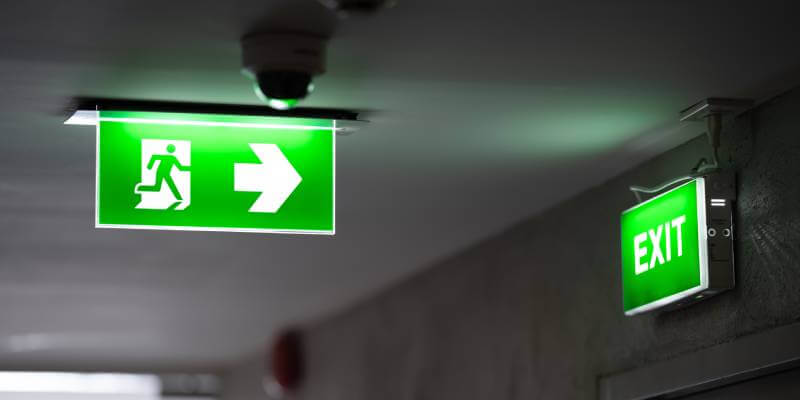
What are the emergency lighting testing requirements UK?
In the UK, emergency lighting testing is governed by the Regulatory Reform (Fire Safety) Order 2005 and the BS 5266 series of British Standards. These set out the legal and technical framework for testing, maintaining, and recording results.
Key requirements include:
- Responsible person: Every business must appoint a responsible person (such as a facilities manager, landlord, or building owner) to ensure compliance.
- Testing frequency: Monthly flick tests and annual full duration tests (explained in the next section).
- Logbook recording: All test results – including dates, test types, and any faults found – must be recorded in an emergency lighting logbook. This provides evidence of compliance during inspections.
- Maintenance obligations: Any faulty lights or batteries discovered during testing must be repaired or replaced without delay.
- Penalties for non-compliance: Failure to comply with the regulations can result in substantial fines, prosecution, and even imprisonment in serious cases where lives are put at risk.
For more detailed technical guidance, you can refer to the BSI Group overview of BS 5266.
Heath Electrical Services stays up to date with all relevant regulations to ensure that the emergency lighting systems we install and maintain are fully compliant with current UK safety standards.
How often should emergency lighting be tested?
Emergency lighting systems require testing on a monthly and annual basis:
- Monthly flick test: This quick test can usually be carried out by the responsible person on-site. It involves briefly switching off the mains power and checking that all emergency lights illuminate. Results should be recorded in the logbook.
- Annual full duration test: This must be carried out by a qualified and competent person – such as a NICEIC-approved electrician. It involves running the emergency lights for the full three-hour duration to confirm that the batteries last as required.
At Heath Electrical Services, we provide annual emergency light testing as either a one-off service or as part of a planned preventative maintenance programme. This ensures you don’t miss any testing dates and gives you peace of mind that your systems will always be compliant.
How to test emergency lights
If you’re carrying out the monthly flick test yourself, here’s a step-by-step process:
- Locate the test switch or breaker: Find the special “fish key” socket or identify the correct circuit breaker in the electrical cupboard.
- Activate test mode: Insert the fish key and turn it, or switch off the circuit breaker to simulate a power failure.
- Observe the lights: Check that all emergency lights automatically illuminate and remain lit.
- Restore power: Return the switch to normal mode or turn the circuit breaker back on.
- Record results: Note the date, test type, and outcome in your emergency lighting logbook.
When a professional electrician carries out the annual full duration test, the process is more detailed:
- Visual inspection: Checking all fittings for physical damage, dirt, or corrosion.
- Functional check: Simulating a full power cut and running the lights for three hours.
- Lux measurement: Measuring the actual brightness (lux levels) to ensure minimum illumination is achieved.
- Battery recharge: Once the test is complete, mains power is restored and batteries are allowed to recharge for at least 24 hours.
This ensures that your emergency lighting is not just functional, but fully compliant with UK standards.
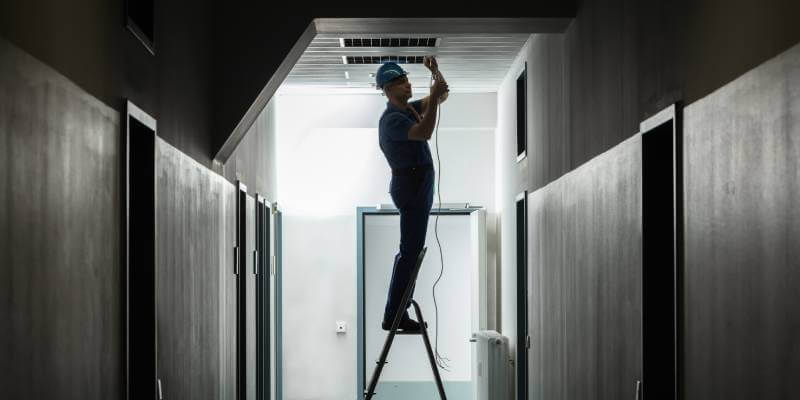
Why professional testing matters
While monthly flick tests can be done in-house, annual full duration testing requires specialist knowledge and equipment. Here’s why using a professional electrician is so important:
- Compliance: Professionals are trained to carry out tests in line with BS 5266 and current legislation.
- Accuracy: Electricians can measure light output and battery performance more reliably than a visual check alone.
- Safety: Incorrect testing could damage fittings or disrupt your electrical systems.
- Documentation: A professional will provide the necessary certification and records to prove compliance during audits.
- Peace of mind: You’ll know your emergency lighting will function correctly in a real emergency.
Heath Electrical Services has decades of experience providing emergency light testing for commercial clients, landlords, and public sector organisations. We tailor our services to your property’s specific needs, ensuring both safety and compliance.
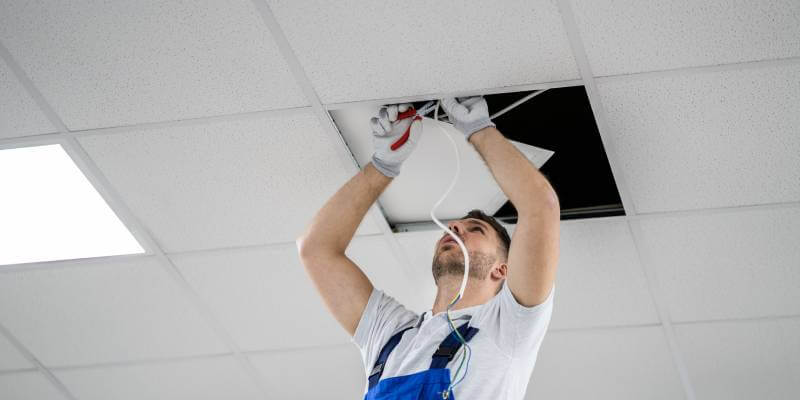
Keep your premises safe with Heath Electrical Services
Emergency lighting is more than just a legal requirement – it’s a life-saving system that ensures people can safely exit your building in an emergency. Regular testing is essential to keep these systems working, maintain compliance, and protect both occupants and property.
At Heath Electrical Services, we combine years of experience with industry-leading accreditations, including NICEIC approval and ECA membership, to deliver reliable and professional emergency lighting services. Whether you need a one-off test, a complete installation, or ongoing maintenance, our friendly and skilled team is here to help.
Don’t wait until an emergency happens to find out your lights don’t work. Contact our electricians in Leighton Buzzard, Milton Keynes, and the surrounding areas to book your emergency light testing and keep your premises safe, compliant, and fully prepared.



